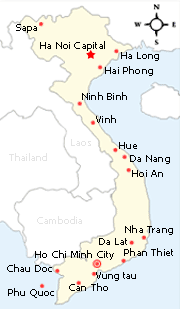|
Ba The - Land of the Oc Eo culture The culture of Oc Eo is the general name of a civilization attached to the kingdom of legendary Phu Nam. It appeared at the same time as Phu Nam inhabitants of the ancient land of the South from the 2nd century to the end of the 6th century. Ba The is where Oc Eo culture had the most development with thousands of antiques excavated such as jewelries made from pottery, stone, gold and bronze and many stone statues influenced by Buddhism and Hinduism such as statues of the Buddha, sacred objects of Yoni and Linga and an impressive group of Ganesa statues with an elephant head on a human body.
From Long Xuyen City to Provincial Road 943 and then west about 35 kilometers, tourists will arrive at Ba The Mountain, also known as Vong The. This mountain is located in Oc Eo hamlet in An Giang province’s Thoai Son district. There’s a winding concrete road to the top of the mountain. In 2002, this road was built by the government to serve tourism. At the top of Ba The Mountain is an ancient pagoda named Son Tien Tu which was built in 1933. Standing impressively in front of the pagoda is an 8-meter high statue of Quan The Am Buddha. Here, clouds bring cool dew that flies slowly through the sky. Trees stretch green as far as the eye can see and birds sing everywhere. People are dazed by the pagoda’s bell that periodically rings vibrantly over the forest. Beside Son Tien Tu is a 3-meter high granite stone with a diameter large enough for four or five people to surround. On this huge stone’s surface is a footprint which is bigger than a normal human footprint. People call it a ban chan tien, or a fairy’s foot. This originated from a legend that at the beginning of the mountain, stones were soft like clay and a fairy pressed his foot to make this mark. About ten kilometers from Son Tien Tu is a strange-looking house with a front door facing the direction of the rising sun following the Hindu pattern and containing many antiques related to the history and culture of Ba The-Oc Eo. Architecturally, this house looks like a lot of the temples found in South Asian countries with its dome and its rectangular door. The walls of the house are lined with statues of Ganesa deities with elephant heads on human bodies sitting majestically. The banisters are decorated with many small statues of a kind of Arabian horse. Standing at the top of Ba The Mountain in the evening to look at the kitchen smoke that looms over the plains, tourists find peace in this world of dusk. VietNamNet/SGT
Other news for Wednesday 21 October, 2009 View all news for Wednesday 21 October, 2009 on one page News for Tuesday 20 October, 2009 View all news for Tuesday 20 October, 2009 on one page Recent News
|










